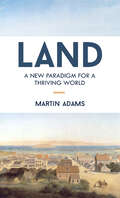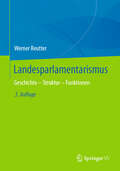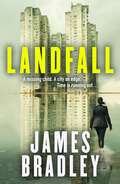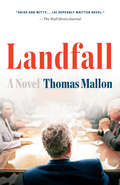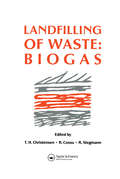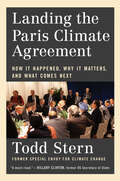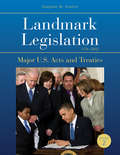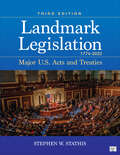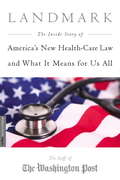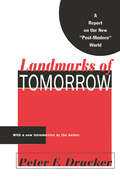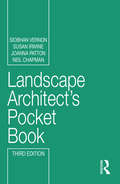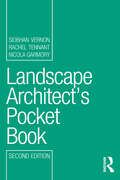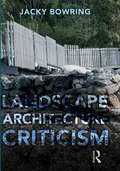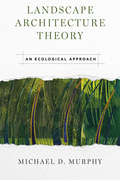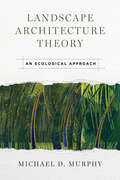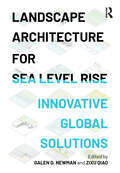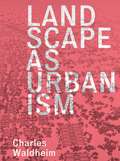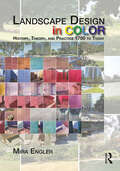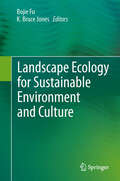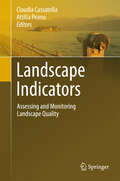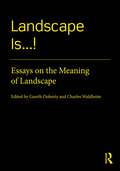- Table View
- List View
Land: A New Paradigm for a Thriving World
by Martin AdamsWhat if we lived in a world where everyone had enough? A world where everyone mattered and where people lived in harmony with nature? What if the solution to our economic, social, and ecological problems was right underneath our feet? Land has been sought after throughout human history. Even today, people struggle to get onto the property ladder and view real estate as an important way to build wealth. Yet, as the reader will discover through this book, the act of owning land—and our urge to profit from it—causes economic booms and busts, social and cultural decline, and environmental devastation. Land: A New Paradigm for a Thriving World introduces a radically new economic model that ensures a more fair and abundant reality for everyone. It is a book for those who dream of a better world, for themselves and future generations.Table of ContentsIntroduction Part I: The Cost of Ignorance1. The Production of Wealth 2. The Value of Location3. The Free Market4. Social Decline5. Business Recessions6. Ecocide7. Earth, Our HomePart II: A New Paradigm for a Thriving World8. Restoring Communities9. Keep What You Earn, Pay for What You Use10. Local Autonomy11. Affordable Housing12. Thriving Cities13. Sustainable Farming14. The Price of Peace15. A New ParadigmEpilogue: A Personal NoteAppendix: The Math Behind the ScienceReferences & Suggestions for Further ReadingEndnotesIndex
Landesparlamentarismus: Geschichte - Struktur - Funktionen
by Werner ReutterDieser Band bietet eine Bestandsaufnahme der Funktionsweisen, der Aufgaben und der Stellung der Landesparlamente in den einzelnen Bundesländern. Er informiert über die historische Entwicklung und verfassungsrechtlichen Voraussetzungen der 16 Landesparlamente, stellt die jeweiligen Parteienlandschaften, das Wahlrecht und die Wahlergebnisse vor, analysiert die politische und soziale Zusammensetzung sowie die Struktur und Organisation der Landesparlamente und untersucht schließlich den Funktionswandel dieser Institutionen. Für die 3. Auflage wurde er umfassend aktualisiert und erweitert.
Landfall
by James BradleyA gripping near-future thriller exploring the detrimental effects of climate change on ordinary lives.
Landfall: A Novel
by Thomas MallonSet during the tumultuous middle of the George W. Bush years—amid the twin catastrophes of the Iraq insurgency and Hurricane Katrina—Landfall brings Thomas Mallon's cavalcade of contemporary American politics, which began with Watergate and continue with Finale, to a vivid and emotional climax.The president at the novel's center possesses a personality whose high-speed alternations between charm and petulance, resoluteness and self-pity, continually energize and mystify the panoply of characters around him. They include his acerbic, crafty mother, former First Lady Barbara Bush; his desperately correct and eager-to-please secretary of state, Condoleezza Rice; the gnomic and manipulative Donald Rumsfeld; foreign leaders from Tony Blair to Vladimir Putin; and the caustic one-woman chorus of Ann Richards, Bush's predecessor as governor of Texas. A gallery of political and media figures, from the widowed Nancy Reagan to the philandering John Edwards to the brilliantly contrarian Christopher Hitchens, bring the novel and the era to life.The story is deepened and driven by a love affair between two West Texans, Ross Weatherall and Allison O'Connor, whose destinies have been affixed to Bush's since they were teenagers in the 1970s. The true believer and the skeptic who end up exchanging ideological places in a romantic and political drama that unfolds in locations from New Orleans to Baghdad and during the parties, press conferences, and state funerals of Washington, D.C.
Landfilling of Waste: Biogas
by T. H. ChristensenLandfilling of Waste: Biogas is the third in a series of reference books which provide a comprehensive overview of the state of the art and identify new directions in landfill technology and landfill research. As well as describing gas generation and composition, the book covers the environmental aspects, discusses gas production, extraction and transportation, treatment and utilization, emissions and safety, and ends with a selection of case studies.
Landing the Paris Climate Agreement: How It Happened, Why It Matters, and What Comes Next
by Todd SternFrom the U.S. lead negotiator on climate change, an inside account of the seven-year negotiation that culminated in the Paris Climate Agreement in 2015—and where the international climate effort needs to go from here.The 2015 Paris Agreement on climate change was one of the most difficult and hopeful achievements of the twenty-first century: 195 nations finally agreed, after 20 years of trying, to establish an ambitious, operational regime to address one of the greatest civilizational challenges of our time. In Landing the Paris Climate Agreement, Todd Stern, the chief US negotiator on climate change, provides an engaging account from inside the rooms where it happened: the full, charged, seven-year story of how the Paris Agreement came to be, following an arc from Copenhagen, to Durban, to the secret U.S.-China climate deal in 2014, to Paris itself. With a storyteller’s gift for character, suspense, and detail, Stern crafts a high-stakes narrative that illuminates the strategy, policy, politics, and diplomacy that made Paris possible. Introducing readers to a vivid cast of characters, including Xie Zenhua, Vice Minister of China’s National Development and Reform Commission, Bo Lidegaard, chief strategist for Denmark’s Prime Minster, and Indian minister Jairam Ramesh, Stern, who worked alongside President Barack Obama and Secretaries of State John Kerry and Hillary Clinton, depicts the pitfalls and challenges overcome, the shifting alliances, the last-minute maneuvering, and the ultimate historic success. The book concludes with a final chapter that describes key developments since 2015 and the author’s reflections on what needs to be done going forward to contain the climate threat.A unique peek behind the curtain of one of the most important international agreements of our time, Landing the Paris Climate Agreement is a vital and fascinating read for anyone who cares about the future of our one shared home.
Landmark Legislation 1774-2012: Major U.S. Acts and Treaties
by Stephen W. StathisThe Second Edition of this renowned treasure trove of information about the most important laws and treaties enacted by the U.S. Congress now deepens its historical coverage and examines an entire decade of new legislation. Landmark Legislation 1774-2012 includes additional acts and treaties chosen for their historical significance or their precedential importance for later areas of major federal legislative activity in the over 200 years since the convocation of the Continental Congress. Brand new chapters expand coverage to include the last five numbered Congresses (10 years of activity from 2003-2012), which has seen landmark legislation in the areas of health insurance and health care reform; financial regulatory reform; fiscal stimulus and the Temporary Asset Relief Program; federal support for stem cell research; reform of federal financial support for public schools and higher education; and much more. Features & Benefits: Each chapter covers one of the numbered Congresses with a historical essay, followed by the major acts of that Congress arranged in chronological order of passage – with each act summarized. A Finder’s Guide summarizes all of the acts and treaties into approximately 40 separate topical policy areas. The work’s extensive bibliography has been expanded and updated. This one-volume resource is a must-have for any public or academic library, especially those with strong American history or political science collections.
Landmark Legislation 1774-2022: Major U.S. Acts and Treaties
by Stephen W. StathisLandmark Legislation 1774-2022, Third Edition is a comprehensive guide to important laws and treaties enacted by the U.S. Congress. This updated edition includes landmark legislation from the last five Congresses (2013-2022) on issues like climate change, criminal justice, education, and more. It features carefully selected acts and treaties with historical significance and has an updated index and bibliography for easy access. A must-have for public and academic libraries with American history or political science collections.
Landmark Legislation 1774-2022: Major U.S. Acts and Treaties
by Stephen W. StathisLandmark Legislation 1774-2022, Third Edition is a comprehensive guide to important laws and treaties enacted by the U.S. Congress. This updated edition includes landmark legislation from the last five Congresses (2013-2022) on issues like climate change, criminal justice, education, and more. It features carefully selected acts and treaties with historical significance and has an updated index and bibliography for easy access. A must-have for public and academic libraries with American history or political science collections.
Landmark: The Inside Story of America's New Health-Care Law-The Affordable Care Act-and What It Means for Us All
by The Staff of The Washington Post"The Washington Post"OCOs must-read guide to the health care overhaul What now? Despite the rancorous, divisive, year-long debate in Washington, many Americans still donOCOt understand what the historic overhaul of the health care system willOCoor wonOCOtOComean. In "Landmark," the national reporting staff of "The Washington Post" pierces through the confusion, examining the new lawOCOs likely impact on us all: our families, doctors, hospitals, health care providers, insurers, and other parts of a health care system that has grown to occupy one-sixth of the U. S. economy. "Landmark"OCOs behind-the-scenes narrative reveals how just how close the law came to defeat, as well as the compromises and deals that President Obama and his Democratic majority in Congress made in achieving what has eluded their predecessors for the past seventy-five years: A legislative package that expands and transforms American health care coverage. "Landmark" is an invaluable resource for anyone eager to understand the changes coming our way.
Landmarks of Tomorrow: A Report on the New Post Modern World
by Peter DruckerLandmarks of Tomorrow forecasts changes in three major areas of human life and experience. The first part of the book treats the philosophical shift from a Cartesian universe of mechanical cause to a new universe of pattern, purpose, and process. Drucker discusses the power to organize men of knowledge and high skill for joint effort and performance as a key component of this change. The second part of the book sketches four realities that challenge the people of the free world: an educated society, economic development, the decline of government, and the collapse of Eastern culture. The final section of the book is concerned with the spiritual reality of human existence. These are seen as basic elements in late twentieth-century society.In his new introduction, Peter Drucker revisits the main findings of Landmarks of Tomorrow and assesses their validity in relation to today's concerns. It is a book that will be of interest to sociologists, economists, and political theorists.
Landscape Agronomy: Advances and Challenges of a Territorial Approach to Agricultural Issues
by Davide Rizzo Elisa Marraccini Sylvie LardonThe landscape is widely identified as a relevant target both by integrative policies and across the disciplines dealing with resource management and territorial planning. Landscape agronomy promotes a greater involvement of agricultural sciences into this arena by increasing the attention on the dynamics relating the farming practices to the natural resources and the temporal and spatial patterns of land covers. This book covers the background that improved the transdisciplinary interface of agronomy with spatially-explicit disciplines like landscape ecology and geography both in research and in training programs, in addition to some experiences of participative landscape management. On these bases, the state of art on cutting-edge data availability and methodological issues is used to select and discuss some worldwide case studies. This selection of research topic examples underpins the concluding discussions about challenges ahead. Researchers as well as policy and decision makers are the main target of this book that seeks to provide a toolbox of concepts, examples and ideas to improve the understanding of agricultural landscapes. Agricultural activities manage the greatest share of land surface on Earth with fast-paced changes compared to any other human land use. With this book we aim at providing a stronger interface between agricultural science and landscape design processes.
Landscape Architect's Pocket Book (Routledge Pocket Books)
by Neil Chapman Siobhan Vernon Susan Irwine Joanna PattonThis third edition of the bestselling Landscape Architect’s Pocket Book, written by leading practitioners, incorporates updates and revisions to environmental and building regulations, contracts, and a range of design guidelines including materials, SuDS, environmental impact, and landscape character assessment. The book is an indispensable tool for all landscape architects, providing a timesaving guide and first point of reference to everyday topics, both out on site and in the office. The pocket book covers all major subjects, including hard and soft landscaping, national guidelines and standards, and key planning policy and legislation. Providing concise, easy-to-read reference material, useful calculations, and instant access to a wide range of topics, it is an essential resource for landscape architects, construction industry professionals, and students.
Landscape Architect's Pocket Book (Routledge Pocket Books)
by Rachel Tennant Nicola Garmory Siobhan VernonAn indispensable tool for all landscape architects, this time-saving guide answers the most frequently asked questions in one pocket-sized volume. It is a concise, easy-to-read reference that gives instant access to a wide range of information needed on a daily basis, both out on site and in the office.Covering all the major topics, including hard landscaping, soft landscaping as well as planning and legislation, the pocket book also includes a handy glossary of important terms, useful calculations and helpful contacts. Not only an essential tool for everyday queries on British standards and procedures, this is a first point of reference for those seeking more extensive, supplementary sources of information, including websites and further publications. This new edition incorporates updates and revisions from key planning and environmental legislation, guidelines and national standards.
Landscape Architecture Criticism
by Jacky BowringLandscape Architecture Criticism offers techniques, perspectives and theories which relate to landscape architecture, a field very different from the more well-known domains of art and architectural criticism. Throughout the book, Bowring delves into questions such as, how do we know if built or unbuilt works of landscape architecture are successful? What strategies are used to measure the success or failure, and by whom? Does design criticism only come in written form? It brings together diverse perspectives on criticism in landscape architecture, establishing a substantial point of reference for approaching design critique, exploring how criticism developed within the discipline. Beginning with an introductory overview to set the framework, the book then moves on to historical perspectives, the purpose of critique, theoretical positions ranging from aesthetics, to politics and experience, unbuilt projects, techniques, and communication. Written for professionals and academics, as well as for students and instructors in landscape architecture, it includes strategies, diagrams, matrices, and full colour illustrations to prompt discussion and provide a basis for exploring design critique.
Landscape Architecture Documentation Standards: Principles, Guidelines And Best Practices
by Design WorkshopAchieve better execution with the documentation standards behind an industry-leading firm Construction Documentation Standards and Best Practices for Landscape Architectural Design offers guidelines, methods, and techniques for creating more robust project documents. Developed and authored by one of the world's leading landscape architectural firms, this material has been field tested by Design Workshop's ten offices and 150 designers to ensure completeness, practicality, and effectiveness. The book provides an overview of the entire design and construction process in the context of actual documentation, with best practice standards for design document content, format, and graphics. Readers learn how to apply these practices to serve the specific needs of different projects, gaining a comprehensive understanding of how complete documentation better serves the project as a whole. Good documentation leads to good execution, which leads to better performance from the perspectives of durability, safety, and user enjoyment. This book presents a set of standards that serve as a roadmap of the design process, helping designers provide the complete documentation that the most highly executed projects require. Discover how documentation ties into project performance Learn the best practices for documenting every stage of the process Study actual project documents serving various project needs Gain documentation insights from one of the world's top firms Design Workshop has been an industry leader since 1969, with projects ranging from resorts, to wildlife refuges, to county master plans. The value of their insight is proven by the continued high performance of their projects across the U. S. and beyond, and this book contains the standards, techniques, and actual documentation behind this success. Better outcomes require better execution, which starts with the documentation standards presented in Construction Documentation Standards and Best Practices for Landscape Architectural Design.
Landscape Architecture Theory: An Ecological Approach
by Michael MurphyFor decades, landscape architecture was driven solely by artistic sensibilities. But in these times of global change, the opportunity to reshape the world comes with a responsibility to consider how it can be resilient, fostering health and vitality for humans and nature. Landscape Architecture Theory re-examines the fundamentals of the field, offering a new approach to landscape design.Drawing on his extensive career in teaching and practice, Michael Murphy begins with an examination of influences on landscape architecture: social context, contemporary values, and the practicalities of working as a professional landscape architect. He then delves into systems and procedural theory, while making connections to ecosystem factors, human factors, utility, aesthetics, and the design process. He concludes by showing how a strong theoretical understanding can be applied to practical, every-day decision making and design work to create more holistic, sustainable, and creative landscapes.Students will take away a foundational understanding of the underpinnings of landscape architecture theory, as well as how it can be applied to real-world designs; working professionals will find stimulating insights to infuse their projects with a greater sense of purpose.
Landscape Architecture Theory: An Ecological Approach
by Michael MurphyFor decades, landscape architecture was driven solely by artistic sensibilities. But in these times of global change, the opportunity to reshape the world comes with a responsibility to consider how it can be resilient, fostering health and vitality for humans and nature. Landscape Architecture Theory re-examines the fundamentals of the field, offering a new approach to landscape design.Drawing on his extensive career in teaching and practice, Michael Murphy begins with an examination of influences on landscape architecture: social context, contemporary values, and the practicalities of working as a professional landscape architect. He then delves into systems and procedural theory, while making connections to ecosystem factors, human factors, utility, aesthetics, and the design process. He concludes by showing how a strong theoretical understanding can be applied to practical, every-day decision making and design work to create more holistic, sustainable, and creative landscapes.Students will take away a foundational understanding of the underpinnings of landscape architecture theory, as well as how it can be applied to real-world designs; working professionals will find stimulating insights to infuse their projects with a greater sense of purpose.
Landscape Architecture for Sea Level Rise: Innovative Global Solutions
by Galen D. Newman Zixu QiaoThis book assesses and illustrates innovative and practical world-wide measures for combating sea level rise from the profession of landscape architecture. The work explores how the appropriate mixture of integrated, multi-scalar flood protection mechanisms can reduce risks associated with flood events including sea level rise. Because sea level rise is a global issue, illustrative case studies performed from the United States, Korea, Australia, New Zealand, Thailand, Japan, China, and the Netherlands identify the structural (engineered), non-structural (nature-based), and hybrid mechanisms (mixed) used to combat sea level rise and increase flood resilience. The alternative flood risk reduction mechanisms are extracted and analyzed from each case study to develop and explain a set of design-based typologies to combat sea level rise which can then be applied to help proctor new and existing communities. It is important for those located within the current or future floodplain considering sea level rise and those responsible for land use, developmental, and population-related activities within these areas to strategically implement a series of integrated constructed and green infrastructure-based flood risk reduction mechanisms to adequately protect threatened areas. As a result, this book is beneficial to both academics and practitioners related to multiple design professions such as urban designers, urban planners, architects, real estate developers, and landscape architects.
Landscape As Urbanism: A General Theory
by Charles WaldheimIt has become conventional to think of urbanism and landscape as opposing one another--or to think of landscape as merely providing temporary relief from urban life as shaped by buildings and infrastructure. <P><P>But, driven in part by environmental concerns, landscape has recently emerged as a model and medium for the city, with some theorists arguing that landscape architects are the urbanists of our age.
Landscape Design in Color: History, Theory, and Practice 1750 to Today
by Mira EnglerArchitects, landscape architects and urban designers experiment with color and lighting effects in their daily professional practice. Over the past decade, there has been a reinvigorated discussion on color within architectural and cultural studies. Yet, scholarly enquiry within landscape architecture has been minimal despite its important role in landscape design. This book posits that though color and lighting effects appear natural, fleeting, and difficult to comprehend, the sensory palette of built landscapes and gardens has been carefully constructed to shape our experience and evoke meaning and place character. Landscape Design in Color: History, Theory, and Practice 1750 to Today is an inquiry into the themes, theories, and debates on color and its impact on practice in Western landscape architecture over the past three centuries. Divided into three key periods, each chapter in the book looks at the use of color in the written and built work of key prominent designers. The book investigates thematic juxtapositions such as: natural and artificial; color and line; design and draftsmanship; sensation and concept; imitation and translation; deception and display; and decoration and structure, and how these have appeared, faded, disappeared, and reappeared throughout the ages. Richly designed and illustrated in full color throughout, including color palettes, this book is a must-have resource for students, scholars, and design professionals in landscape architecture and its allied disciplines.
Landscape Ecology for Sustainable Environment and Culture
by Bojie Fu Bruce Jones KClimate change and the pressures of escalating human demands on the environment have had increasing impacts on landscapes across the world. In this book, world-class scholars discuss current and pressing issues regarding the landscape, landscape ecology, social and economic development, and adaptive management. Topics include the interaction between landscapes and ecological processes, landscape modeling, the application of landscape ecology in understanding cultural landscapes, biodiversity, climate change, landscape services, landscape planning, and adaptive management to provide a comprehensive view that allows readers to form their own opinions. Professor Bojie Fu is an Academician of Chinese Academy of Sciences and Chair of scientific committee at the Research Center for Eco-Environmental Sciences, Chinese Academy of Sciences, Beijing, China. Professor K. Bruce Jones is the Executive Director for Earth and Ecosystem Sciences Division at Desert Research Institute, University of Nevada, Las Vegas, USA.
Landscape Indicators
by Claudia Cassatella Attilia PeanoIn recent years EU policy towards the 'landscape' has become better defined, whereas at the same time the notion of 'landscape' itself remains elusive. The need for indicators to evaluate and monitor the effects of landscape policies and plans is urgent. What is more, landscape is one of the components considered in environmental reporting, but unlike air, soil, or water, it is difficult to measure using quantitative methods. With studies on landscape indicators being as rare as they are, this volume is an attempt to fill the gap, dealing as it does with the definition and use of specific indicators for landscape assessment and monitoring. To tackle the diverse dimensions of the landscape (whose complexity is well known), the subject is approached by a multidisciplinary team of experts in landscape ecology, landscape history, landscape perception, regional planning, strategic environmental assessment and environmental impact assessment procedures, and multi-criteria assessment methods. Individual chapters include comparative assessments of studies conducted thus far in the EU, as well as detailed analyses of ecological, historical, perceptive, land-use, and economic ways of looking at landscape. As well as providing a rich source of references for researchers studying the landscape from a variety of perspectives, the book will be required reading for European officials involved at any level in planning or assessing the landscape or environment.
Landscape Indicators: Assessing and Monitoring Landscape Quality
by Claudia Cassatella Attilia PeanoIn recent years EU policy towards the ‘landscape’ has become better defined, whereas at the same time the notion of ‘landscape’ itself remains elusive. The need for indicators to evaluate and monitor the effects of landscape policies and plans is urgent. What is more, landscape is one of the components considered in environmental reporting, but unlike air, soil, or water, it is difficult to measure using quantitative methods.With studies on landscape indicators being as rare as they are, this volume is an attempt to fill the gap, dealing as it does with the definition and use of specific indicators for landscape assessment and monitoring. To tackle the diverse dimensions of the landscape (whose complexity is well known), the subject is approached by a multidisciplinary team of experts in landscape ecology, landscape history, landscape perception, regional planning, strategic environmental assessment and environmental impact assessment procedures, and multi-criteria assessment methods. Individual chapters include comparative assessments of studies conducted thus far in the EU, as well as detailed analyses of ecological, historical, perceptive, land-use, and economic ways of looking at landscape.As well as providing a rich source of references for researchers studying the landscape from a variety of perspectives, the book will be required reading for European officials involved at any level in planning or assessing the landscape or environment.
Landscape Is...!: Essays on the Meaning of Landscape
by Charles Waldheim Gareth DohertyLandscape Is...! examines the implicit biases and received meanings of landscape. Following on from the previous publication Is Landscape…? which examined the plural and promiscuous identities of the landscape idea, this companion volume reflects upon the diverse and multiple meanings of landscape as a discipline, profession, and medium. This book is intended for academics, researchers, and students in landscape architecture and cognate disciplines. Chapters address various overlooked aspects of landscape that develop, disturb, and diversify received understandings of the field. Framed as an inquiry into the relationship of landscape to the forms of human subjectivity, the book features contributions from leading voices who challenge the contemporary understandings of the field in relation to capital and class, race and gender, power and politics, and more.
